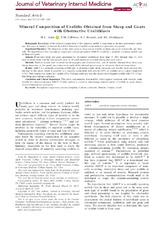| dc.creator | Jones, Meredyth L | |
| dc.creator | Gibbons, Philippa M. | |
| dc.creator | Roussel, Allen J. | |
| dc.creator | Dominguez, Brandon J | |
| dc.date.accessioned | 2018-05-18T22:04:30Z | |
| dc.date.available | 2018-05-18T22:04:30Z | |
| dc.date.issued | 2017 | |
| dc.identifier.citation | Jones ML, Gibbons PM, Roussel AJ, Dominguez BJ. Mineral Composition of Uroliths Obtained from Sheep and Goats with Obstructive Urolithiasis. Journal of Veterinary Internal Medicine. 2017;31(4):1202-1208. doi:10.1111/jvim.14743. | en |
| dc.identifier.uri | https://hdl.handle.net/1969.1/166425 | |
| dc.description.abstract | Background: Knowledge of the mineral composition of the causative urolith is important to develop preventative strategies. Advances in analytic techniques have led to detection of urolith components not previously recognized. Hypothesis/Objectives: The objectives of this study were to characterize uroliths in sheep and goats structurally and clinically. We hypothesized that amorphous magnesium calcium phosphate (AMCP) would be a naturally occurring urolith type in sheep and goats. Animals: Forty-nine sheep and goats presenting for obstructive urolithiasis from June 15, 2014 through June 14, 2016 were reviewed along with the demographic data of all small ruminants admitted during that same period. Methods: Medical records were reviewed for demographic and historical data, and 36 uroliths obtained from these cases during diagnostic or therapeutic procedures were analyzed by infrared spectroscopy to determine chemical composition. Results: AMCP is a naturally occurring urolith type in obstructed male sheep and goats and was the most common urolith type in this study, where it occurred as a majority component with struvite (39% of uroliths) or as a pure component (11%). Pure struvite was found in 1 urolith (2%). Calcium carbonate was the second most frequent urolith with 31% of uroliths being pure calcium carbonate. Conclusions and Clinical Importance: This study demonstrates that uroliths, which appear consistent with struvite, could actually be calcium-containing AMCP. Urolith analysis is critical in determining mineral content of uroliths to guide dietary recommendations for prevention. Key words: Amorphous magnesium calcium phosphate; Calcium carbonate; Struvite; Urinary calculi. | en |
| dc.description.sponsorship | This work was supported by funds from the Department of Large Animal Clinical Sciences, Texas A&M University College of Veterinary Medicine, College Station, TX, USA.The open access publishing fees for this article have been covered by the Texas A&M University Open Access to Knowledge Fund (OAKFund), supported by the University Libraries and the Office of the Vice President for Research. | en |
| dc.language.iso | en_US | |
| dc.publisher | American College of Veterinary Internal Medicine | |
| dc.rights | Attribution-NonCommercial-ShareAlike 3.0 United States | en |
| dc.rights.uri | http://creativecommons.org/licenses/by-nc-sa/3.0/us/ | |
| dc.subject | Veterinary Medicine | en |
| dc.subject | Amorphous magnesium calcium phosphate | en |
| dc.subject | Calcium carbonate | en |
| dc.subject | Struvite | en |
| dc.subject | Urinary calculi | en |
| dc.subject | Goats | en |
| dc.subject | Sheep | en |
| dc.title | Mineral Composition of Uroliths Obtained from Sheep and Goats with Obstructive Urolithiasis | en |
| dc.type | Article | en |
| local.department | Large Animal Clinical Sciences | en |
| dc.identifier.doi | 10.1111/jvim.14743 | |



